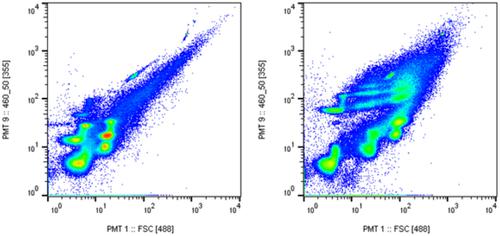当前位置:
X-MOL 学术
›
Cytom. Part A
›
论文详情
Our official English website, www.x-mol.net, welcomes your
feedback! (Note: you will need to create a separate account there.)
Bacterial Community Diversity Dynamics Highlight Degrees of Nestedness and Turnover Patterns.
Cytometry Part A ( IF 2.5 ) Pub Date : 2020-01-16 , DOI: 10.1002/cyto.a.23965 Zishu Liu 1 , Susann Müller 1
Cytometry Part A ( IF 2.5 ) Pub Date : 2020-01-16 , DOI: 10.1002/cyto.a.23965 Zishu Liu 1 , Susann Müller 1
Affiliation

|
Bacterial communities change their structure rapidly due to short generation times of their members. How bacteria assemble to certain structures provides insight into ecological mechanisms that shape a bacterial community. Microbial community flow cytometry was used to create community fingerprints based on subcommunity distributions and to visualize the dynamic variations of 10 independently grown communities under equal conditions. Inventory diversity values were recorded by α‐ and γ‐diversity whereas the degree of subsistence of subcommunities (nestedness) and the degree of gain or loss of subcommunities (turnover) was calculated as multi‐sites ß‐diversity terms ßNES and ßSIM. Numbers of unique subcommunities of pairwise samples were determined by intra‐ and inter‐community ß‐diversity values. Although all communities were exposed to niche‐differentiating conditions they assembled to disparate structures. In our study, the turnover coefficients were high (> 0.6), while the nestedness coefficients were complementary low in the separate 10 bioreactors. Intra‐ and inter‐community ß‐diversity values indicated fast community shifts. Microbial community flow cytometry straightforwardly identifies the dominance and subsistence of subsets of cells in a community or the degree of their replacement. The calculation of either turnover or nestedness patterns might have implications in medical, biotechnological, or environmental research. © 2020 The Authors. Cytometry Part A published by Wiley Periodicals, Inc. on behalf of International Society for Advancement of Cytometry.
中文翻译:

细菌群落多样性动态突出了嵌套和周转模式的程度。
由于其成员的世代时间短,细菌群落会迅速改变其结构。细菌如何组装成某些结构可以深入了解塑造细菌群落的生态机制。微生物群落流式细胞术用于根据亚群落分布创建群落指纹,并在相同条件下可视化 10 个独立生长的群落的动态变化。库存多样性值由α-和γ-多样性记录,而子社区的生存程度(嵌套)和子社区的获得或损失程度(周转)计算为多站点ß-多样性项ß NES和ß SIM. 成对样本的独特子群落的数量由群落内和群落间 ß 多样性值确定。尽管所有社区都暴露于生态位差异化条件下,但它们组装成不同的结构。在我们的研究中,周转系数高 (> 0.6),而嵌套系数在单独的 10 个生物反应器中互补性低。社区内和社区间 ß 多样性值表明社区快速变化。微生物群落流式细胞术可直接识别群落中细胞亚群的优势和生存情况或其替代程度。周转或嵌套模式的计算可能对医学、生物技术或环境研究产生影响。© 2020 作者。流式细胞术 A 部分 由 Wiley Periodicals, Inc. 代表 International Society for Advancement of Cytometry 出版。
更新日期:2020-01-16
中文翻译:

细菌群落多样性动态突出了嵌套和周转模式的程度。
由于其成员的世代时间短,细菌群落会迅速改变其结构。细菌如何组装成某些结构可以深入了解塑造细菌群落的生态机制。微生物群落流式细胞术用于根据亚群落分布创建群落指纹,并在相同条件下可视化 10 个独立生长的群落的动态变化。库存多样性值由α-和γ-多样性记录,而子社区的生存程度(嵌套)和子社区的获得或损失程度(周转)计算为多站点ß-多样性项ß NES和ß SIM. 成对样本的独特子群落的数量由群落内和群落间 ß 多样性值确定。尽管所有社区都暴露于生态位差异化条件下,但它们组装成不同的结构。在我们的研究中,周转系数高 (> 0.6),而嵌套系数在单独的 10 个生物反应器中互补性低。社区内和社区间 ß 多样性值表明社区快速变化。微生物群落流式细胞术可直接识别群落中细胞亚群的优势和生存情况或其替代程度。周转或嵌套模式的计算可能对医学、生物技术或环境研究产生影响。© 2020 作者。流式细胞术 A 部分 由 Wiley Periodicals, Inc. 代表 International Society for Advancement of Cytometry 出版。











































 京公网安备 11010802027423号
京公网安备 11010802027423号